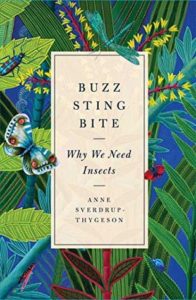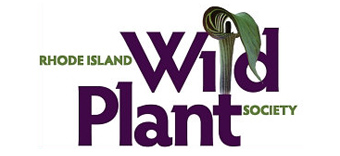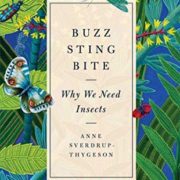Book Review: Buzz, Sting, Bite: Why We Need Insects
Buzz, Sting, Bite: Why We Need Insects By Anne Sverdrup-Thygeson and translated by Lucy Moffatt
–Review by Pat Cahalan
This review first appeared in our WildfloraRI, Winter 2020
 Entomologist Anne Sverdrup-Thygeson really likes bugs. In this book she takes us on a romp through the world of insects, delighting us with tales about these fascinating, curious, and sometimes funny creatures, delving into their anatomy, adaptability, and the myriad ways they make our world livable.
Entomologist Anne Sverdrup-Thygeson really likes bugs. In this book she takes us on a romp through the world of insects, delighting us with tales about these fascinating, curious, and sometimes funny creatures, delving into their anatomy, adaptability, and the myriad ways they make our world livable.
It’s that anatomy and adaptability that has enabled them to survive five rounds of mass extinction, from before the days of the dinosaurs. She tells of flies with tongues on their feet, bugs with ears on their knees (and other seemingly unlikely places), insects with vision ranging from acute to blind, and mind-boggling sex lives. The dragonfly is so well adapted to its mission as a hunter (a 95% success rate) with wings, eyes, and brain superbly suited to its task that the US Army has studied it as a model for drone design.
Svedrug-Thygeson’s point: these tiny fascinating creatures, so often either taken for granted or looked down upon by us humans, are highly deserving of our respect. In fact, we couldn’t live without them. She quotes Harvard biologist E. O. Wilson, who writes: “The truth is that we need invertebrates but they don’t need us. If human beings were to disappear tomorrow, the world would go on with little change . . . But if invertebrates were to disappear, I doubt the human species could live more than a few months.”
We are all familiar with the contribution of insects as pollinators. But we owe them for so much more.
Just imagine, she asks of us, what life would be like without their janitorial services: As life dies off, the insects move in to clean up, recycling the nutrients to the soil, allowing new life to grow. Without them our planet would soon be awash in dead plants, animal carcasses, and dung.Without them we wouldn’t have beeswax, silk, carmine dye, chocolate, shellac, and Shakespeare’s plays (written with long-lasting iron gall ink derived from oak tree galls).
And that’s not all. Blowfly larval therapy is being used to tackle drug-resistant bacteria, and crickets as pets can improve our mental health. One day it may even be possible to send a cockroach with a microchip in its backpack on a rescue mission in a collapsed building.
And insects may one day provide healthy, environmentally friendly food. The “livestock” reproduces rapidly using little space, food, or water. It provides a high-protein food while emitting minimal climate-changing gas. What’s more, it can be raised on our food waste. Research is already underway on using it as feed for fish, poultry, pigs, and dogs. And with proper marketing and processing, it could even become food for human consumption.
And what about all that “nonbiodegradable” plastic littering our planet? Sverdrup-Thygeson tells of one study where mealworms gobble up polystyrene, leaving behind only some carbon dioxide and a spot of beetle poo. And another where the greater wax moth ate holes in polyethylene, the kind of plastic used in supermarket shopping bags, leaving behind only ethylene glycol, familiar to us as antifreeze. The challenge is finding ways to put this knowledge to practical use.
But insects are in severe decline. Anne Sverdrup-Thygeson’s delightful, and carefully researched book, with 20 pages of chapter-by-chapter citations gives us a new respect for these tiny creatures that accomplish so much for us — and underscores the need to help them survive. She points out that “we never know which species will turn out to be useful next.”





